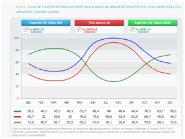Source:
Technical igK Dpt.
18 October 2013
Planning Curve
Agronomic forecasting models are key to turfgrass quality and sustainability.
 Curva
Curva
The growth potential rate shares similarities with monitoring phenological rates commonly associated with agricultural crops. Plant phenology studies the relation between climate factors and plant development (germination, flowering, fruit, etc.), of both herbaceous crops and fruit trees.
Most of the processes leading to different plant stages are identified by climate factors, among which, temperature is one of the most influential factors, but not the only one. This modeling is used to obtain an agroclimatic study associated to a given crop.
In this case adapting turfgrass crops is made possible thanks to the development of the equation GP= e -0,5 (t-to/var)2 , by Doctors Stowell and Gelernter (PaceTurf, 2005). The Growth Potential Rate is used to obtain an estimate of the most likely behavior and development of a turfgrass surface in a given area, considering monthly temperature measurements at the site in question and the optimum growth temperature of each one of the turfgrass types and species. To the extent that the average monthly temperature approaches the optimum for the growth of the respective warm or cool season species, the growth potential rate will approach 100%.
They enable creating forecasting models and choosing the most suitable species when installling projects for sports, gardens and ornamental lawns. They likewise make it possible to plan maintenance tasks for established turfgrass.
The greenkeeper's goal is to maintain a turfgrass surface as a natural and perennial grassland in the best conditions in every season of the year so that it is suitable for its level and intensity of use and with the fewest resources possible.
Besides the species most adapted to the project, there are other questions that can be solved with this type of agronomic forecasting model. It is also useful for estimating nitrogen needs, as well as the optimum seeding window, overseeding periods, activity pest forecasting, aerating proper dates and maintenance task planning, determining the winterkill, dormant periods, and green up season for warm season grasses.
In short, planning curve for turfgrass is a forecasting model enables a more sensible application of agronomy, which optimizes costs, improves turfgrass quality and improves environmental sustainability.